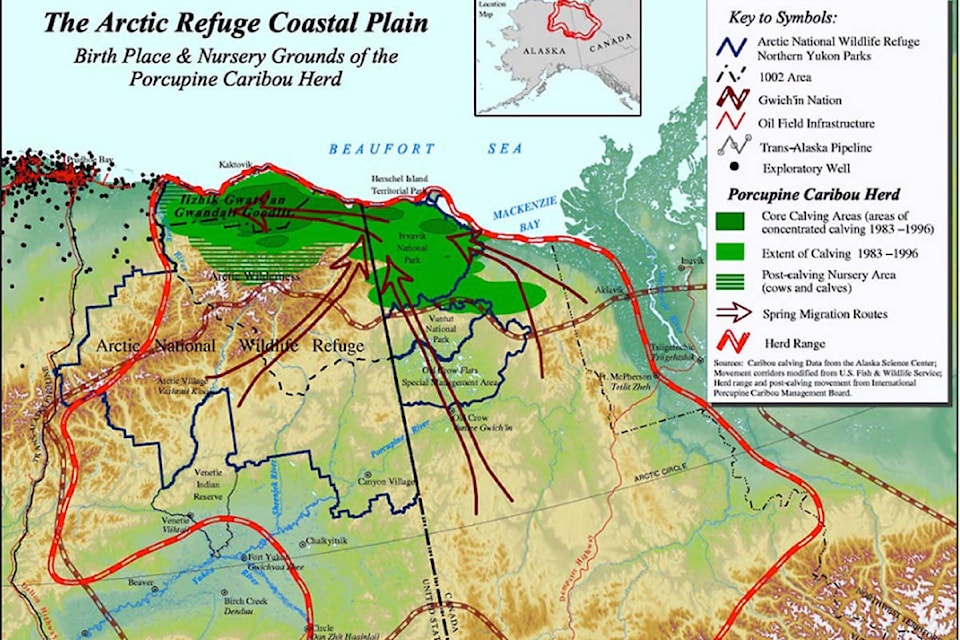U.S. departments have “unlawfully” withheld records about the oil and gas program in the Arctic National Wildlife Refuge (ANWR), alleges a lawsuit filed by Indigenous and environmental groups this week.
Nine freedom of information requests submitted between Dec. 21, 2018 and March 8, 2019 have yet to be responded to, the complaint alleges. Legislated time constraints have been blown, it continues, violating laws intended to streamline the delivery of information deemed to be of public interest.
“The circumstances surrounding the withholdings raise questions regarding whether agency personnel acted arbitrarily or capriciously. …” it says.
The Department of the Interior, the Bureau of Land Management (BLM) and the Fish and Wildlife Service are the defendants.
Spokespeople from BLM and Interior told the News they can’t comment on ongoing litigation (the lawsuit was filed in the U.S. District Court of Alaska on July 31.)
“The way they’re going about this process is extremely sloppy,” said Bernadette Demientieff, executive director of the Gwich’in Steering Committee, one of the plaintiffs, adding that the entire project has been put on the fast track, which is likely causing departments to rush and trip up. “It’s just disrespectful, all the way around.
“They’re just moving along, moving ahead. They have to understand that there’s real people who are going to be affected by their actions. If they’re so confident in their work, there should be no reason to withhold information.”
The steering committee, Alaska Wilderness League, Defenders of Wildlife and the Wilderness Society have been seeking information related to three-dimensional seismic testing plans, the draft environmental impact statement (EIS), which was released late last year, and other inter-governmental communications related to the oil and gas program.
Responses vary from being 71 to 121 days past deadlines, it says, noting that an agency has 20 to respond and determine whether information will be released and, if so, how much.
It’s after this point that a department can request a 10-day extension for requests involving “unusual circumstances,” but it must specify to a requester what they are. Then in order to potentially meet the time limit or come up with a new one, the request must be reworked and perhaps narrowed.
“Defendants have failed to provide a written notice to plaintiffs asserting that ‘unusual circumstances’ prevented them from compliance with FOIA’s decision deadlines,” the complaint says. “As of the date this action was filed, the defendants have not provided final determinations on any of the plaintiffs’ FOIA requests there are pending with defendants.”
According to the complaint, the plaintiffs followed up with departments several times. Each instance was punctuated with a “final demand letter,” which specified legal recourse if answers weren’t provided.
“Federal law is pretty clear that under the Freedom of Information Act we’re entitled to get information about these important projects within a specified period of time,” said Jason Rylander, senior attorney with Defenders of Wildlife. “We’ve waited now a long time, well beyond statutory deadlines for this information and we haven’t gotten it yet.”
The lawsuit, he continued, is an attempt to lift the veil on the stonewalling of information related to the oil and gas program in ANWR while holding President Donald Trump’s administration accountable.
“(It’s) just blatant disregard for transparency and, frankly, a lack of commitment to the mission of protecting our public lands for current and future generations. We’re gonna try and continue to bring as much to light as possible, then hopefully use some of that information to make sure that these projects either don’t go forward or do go forward and as minimally impactful as possible.”
In December 2017, ANWR’s coastal plain was opened up to the possibility of oil and gas leases when the Trump administration inserted a rider into the Tax Cuts and Jobs Act.
The U.S. legislation stipulates that one lease must be issued in four years and that no fewer than two lease sales, each to include at least 400,000 acres with the highest potential of hydrocarbons, must occur by 2024.
U.S. officials have told this newspaper that a final EIS would be released this summer. This hasn’t occurred yet.
It’s been projected that the first lease sale is to happen this year.
Contact Julien Gignac at julien.gignac@yukon-news.com
